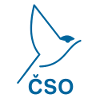SYLVIA publishes original studies on all aspects of ornithology. Accepted languages are English or Czech (Slovak). Sylvia publishes Reviews and Original Articles of any length, Short Notes exceeding no more than two printed pages, and critical Book Reviews. All manuscripts are peer reviewed. The authors have the option to choose a double-blind reviewing. Please send the manuscripts to: sylvia birdlife.cz. Alternatively, send three hard copies to the Editor-in-Chief. The text should be double spaced and with wide margins. Number all pages consecutively and insert line numbers. Scientific names of genera and lower taxa should be in italics but may be underlined when typed. Vernacular names should start with capitals, e.g. Garden Warbler. Do not capitalise group names, e.g. warblers, corvids. Provide full details of statistical analyses and always report the sample sizes. After acceptance, authors will receive page proofs for approval which must be returned within two days. No major modifications are allowed at this stage. The authors automatically agree with transfer of copyright to the publisher (Czech Society for Ornithology) when sending the page proofs to the Editor. The corresponding author will receive a complimentary issue of Sylvia and the final PDF file of her/his paper. The authors may freely distribute the article for non-commercial purposes; they may also post it on their personal website provided that the appropriate acknowledgement to the Czech Society for Ornithology and full bibliographic reference of the article are given.
birdlife.cz. Alternatively, send three hard copies to the Editor-in-Chief. The text should be double spaced and with wide margins. Number all pages consecutively and insert line numbers. Scientific names of genera and lower taxa should be in italics but may be underlined when typed. Vernacular names should start with capitals, e.g. Garden Warbler. Do not capitalise group names, e.g. warblers, corvids. Provide full details of statistical analyses and always report the sample sizes. After acceptance, authors will receive page proofs for approval which must be returned within two days. No major modifications are allowed at this stage. The authors automatically agree with transfer of copyright to the publisher (Czech Society for Ornithology) when sending the page proofs to the Editor. The corresponding author will receive a complimentary issue of Sylvia and the final PDF file of her/his paper. The authors may freely distribute the article for non-commercial purposes; they may also post it on their personal website provided that the appropriate acknowledgement to the Czech Society for Ornithology and full bibliographic reference of the article are given.
ARTICLES – Front page should be arranged in the sequence: (1) title, (2) author’s full given name(s) and family name, (3) author’s address (institutional affiliation, e-mail address and phone number), (4) abstract, (5) keywords, (6) running head proposed. Title should be short and concise. The abstract (200 words) should reflect both content and emphasis of the paper and should be complete in itself without reference to other parts of the paper. Avoid too many subdivisions, do not use more than three different types of headings, and headings should not be numbered. Subdivisions should include: Introduction, Methods, Results, Discussion, Acknowledgements, Summary, and References. The introduction should outline the problem and denote scope, purpose and rationale of the study. Results should answer questions posed at the outset of the paper. Discussion should include the main contributions of the study in relation to the findings of previous workers, but authors may also express their own opinions and ideas on their responsibility. Summary (min. 300 words) will be translated into Czech by editors.
SHORT NOTES should not exceed two pages in print and should not include more than either one table or figure. Short notes consist of text without headings, and a reference list. Acknowledgements are incorporated in the text and there is only a very short abstract.
Cited LITERATURE Only published papers or those which have been accepted for publication are allowed in the list. In the latter case, give the notation ‘in press’ and mention title of the journal in which it will appear. Unpublished data, manuscripts in preparation and unpublished papers should be noted as ‘in litt.’, ‘pers. comm.’ or ‘unpubl. data’. Check your citations carefully against the reference list and vice versa. Examples of literature cited in the text: (Leisler 1991), (Hudec & Černý 1972) or in case of more than two authors (Bejček et al. 1990). Within a sentence: Leisler (1991). References in the text should be in order of publication, e.g. (Hudec & Černý 1972, 1977, Hudec 1994). In the reference list, the literature cited should be in alphabetical order. Titles should be given in the original languages. Use English translation for titles in non-Roman alphabet. Abbreviate journal titles according to the Serial Sources for the Biosis Data Base. If in doubt, give the full journal name.
Examples:
Bejček V., Exnerová A., Fuchs R., Musil P., Šimek L., Šťastný K. & Vašák P. 1990: Changes in the abundance of waterfowl on the fishponds in the region „Třeboňsko“ (Southern Bohemia). Proc. XIst Int. Conf. on Bird Census and Atlas Work, Prague 1989: 437-440.
Hora J. 1990: Základní informace o populaci labutě velké, Cygnus olor (Gm.), v Jihočeském kraji. In: Ptáci v kulturní krajině, Sborník referátů, České Budějovice 1989: 103-118.
Hudec K. & Černý W. (eds) 1972: Fauna ČSSR. Ptáci 1. Academia, Praha.
Hudec K. (ed.) 1994: Fauna ČR a SR. Ptáci 1. Academia, Praha.
Ketzenberg C. 1999: Grundstoffwechsel und untere kritische Temperatur bei Goldregenpfeifern (Pluvialis apricaria). Vogelwarte 40: 139-142.
Leisler B. 1991: Acrocephalus melanopogon (Temminck, 1823) – Mariskensänger. In: Glutz von Blotzheim U. N. & Bauer K. M. (eds): Handbuch der Vögel Mitteleuropas 12/I. AULA-Verlag, Wiesbaden: 217-252.
Internet sources:
IPCC 2007: Climate change 2007: Synthesis report. https://www.ipcc.ch/pdf/assessment-report/ar4/syr/ar4_syr.pdf. Viewed 30 Jun 2008.
Avoid using electronic sources wherever possible. Refer to web sites only if the source is reliable and the link is likely to remain available over time.
ILLUSTRATIONS should have solid black lines on pure white or tracing paper. Their layout and type size should be adapted to the expected final size. Do not submit originals of figures before the manuscript is accepted. PHOTOGRAPHS should be of high contrast and must be printed on glossy paper in black-and-white. Figures should be numbered in sequence of their reference in the text. Legends of the figures should be added after the text, on separate, numbered sheets. Graph files should be supplemented by the original data in ASCII or spreadsheet format. TABLES should be concise and self-explanatory, carrying a brief title at the top, further details should be given at the bottom, with cross-references (e.g. asterisks) in the table. Scientific names of species should be used in tables. Each table should be typed/printed on a separate sheet, with horizontal lines only. Tables should be provided as editable Word files, not as pictures. Ensure that the measurements in the tables are in accordance with the text.

